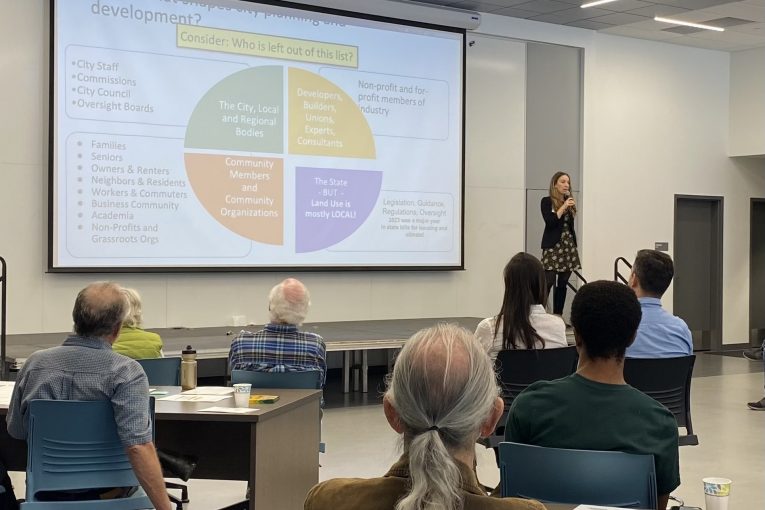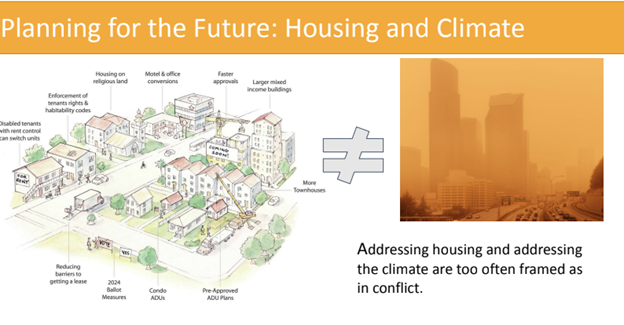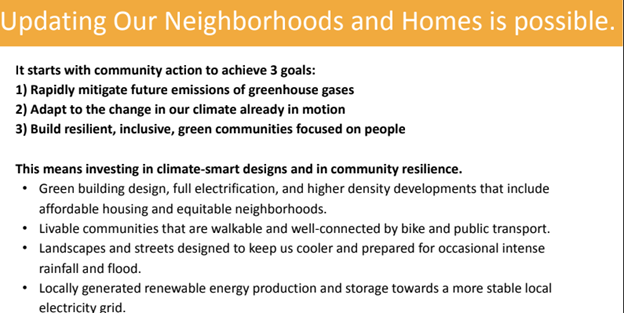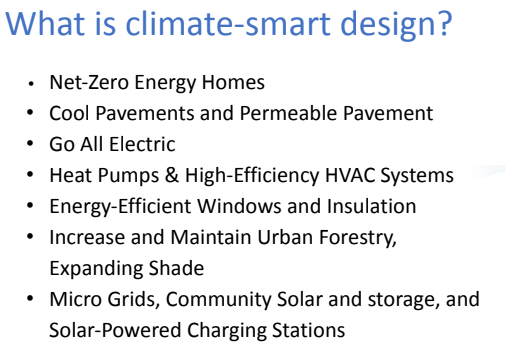

By David M. Greenwald
Executive Editor
Davis, CA – One of the community-based efforts engaging the community on housing took place on Sunday at Da Vinci’s Tech Hub sponsored by Davis Community Action Network (DCAN). The organization is planning to hold up to 15 such smaller events between January and April 2024 with the hope of assisting in a community vision setting for the next General Plan Amendment.
DCAN Director Judy Ennis noted that the League of Women Voters just released a non-partisan survey of a sample of Davis residents, focused on the elements to consider when revising the Davis General Plan.
Not surprisingly Housing was “resoundingly” the top concern for residents. The LWV  survey reached 930 people.
survey reached 930 people.
One of the goals of DCAN is to center the issue of climate change alongside the issue of housing.
“Too often we have housing and potential of building of housing put in opposition to addressing the climate,” Ennis explained. “We disagree with that premise outright.”
She said, “We too often say, think that if we build, we’re going to end up looking like this (the right side of the slide). That’s a design problem and an ongoing humanitarian equity, environmental justice problem that we can design for and we know that we can.”
 The majority of housing currently in Davis, she argued is single family homes.
The majority of housing currently in Davis, she argued is single family homes.
“What we have up here at the top is a breakdown of what the housing stock looks like in Davis today. Right now we’re a majority single family homes, 56%, mostly built up in 1980, i.e. potentially not very climate resilient,” she said.
She said, “We know that single family homes have a larger impact in terms of greenhouse gas emissions. We know that that kind of design has a greater climate impact.”

What we don’t have she continued, is what is known as the “missing middle housing.”
She said, “That’s for families starting out. That’s for seniors that want to downsize. That’s for young couples, that’s for groups of people who don’t have children want to live together. That’s for a wide variety of housing options that are accessible, inclusive, and affordable, often by design. And sometimes they’re affordable in terms of “big a” affordability.”
Davis, she argued is housing overburdened. She looked at the percentage of homeowners spending 30 percent of their income on housing payments.
“This is from 2019,” she explained, “So this does not include the impact of covid and what that threw us all into in terms of economic distress.”

Next she showed that the “situation is even more dire for renters.”
She said, “For our renter community, they are significantly overburdened across the city.”
She noted that she believes, “UC Davis is a huge part of what makes Davis such a wonderful place to live.”
She said, “18% of students have been experiencing homelessness or housing insecurity. That’s an outrageously high number.” The number one cause she said, “is housing costs again and again and again.”
She said, “UC Davis is building more housing. They have 38% now and they’re on their way towards the 48% goal. But that is an area for further conversation.”
Furthermore, she noted that UC Davis employees increasingly cannot afford to live in town.
“57% percent of our UC Davis employees are commuting in,” she said. “That’s more greenhouse gases on the road, but admitted amongst other things that have other environmental impacts from that, and they’re commuting from our wider area. Thinking about housing and thinking about climate action cannot be based on our city borders alone because our city borders are not representative of our whole community.”
Victor Lagunes noted that for DJUSD around 55 of the households are from out of the area.
“That means is a significant minority of employees just within the certificated ranks of teachers, counselors, etc, are outside and are living in the surrounding areas of Woodland. Vacaville, west Sacramento, further in the Sacramento as well,” he explained.
He added, “And also the demographics breakdown is that the people that do live in town tend to be people that are more veteran. That means that their compensation is higher and they were able to either buy in earlier or afford it now – whether that be renting or owning,”
Judy Ennis noted the impact on our schools, “We’re known as being a small town that’s great for families, great schools, and that is true. I’m a very proud DJUSD parent. But we do have declining enrollment.”
Some of that she acknowledged is statewide, “There is statewide declining enrollment for other reasons that are not related to housing costs and more about birth rate. But even so, for the children that are being born right now that we want to have in our school for the next five years, we have more students that we are bringing in from other districts because families can’t afford to live in Davis anymore. New families can’t afford to come in to Davis.”
She said, “This is a reality that we’re looking at, has an impact on our schools, has an impact in terms of our commutes has an impact on our students. This is our community.”
Judy Ennis discussed the current RHNA and the 2075 housing units, 60 percent of which had be low or very low income.
She argued, “The reality is that we are way behind according to the state and SACOG on what we need to be doing to meet our affordable housing and housing goals.”
She argued that we can’t keep building in Davis like it’s 1965 or 2005.
“We must build for 2035 and beyond.”




It was very encouraging to attend this event and meet a big group of fellow Davisites who “get it”. I also really commend Judy and the DCAN team for putting together really well-presented, background info on housing issues.
While a general plan amendment absolutely needs to be undertaken, it should be pointed out that the measure J votes of two housing projects which are substantially out-of-alignment with all of the urban design principles discussed are going to happen WELL before we likely will even START a general plan update.
As Judy put it, very well I think: “We need to transition to a city in which single family homes are a minority of our housing supply, and more sustainable housing forms are the majority”. We don’t get there by building more single family housing developments.
Which to me says that no major projects should be put on the ballot before the update. (That’s the reason I put all 3 of my dots on “Pressure the city council to begin the general plan update” idea at the DCAN gathering.)
I can tell you that if I were asked to vote today on the Village Farms or the Shriners project as currently proposed, I’d vote No. They’re simply the wrong kind of development for the present day.
How quickly do you think a General Plan can be done?
Amen.
Problem is: if they get voted down, and then measure J is taken out, (which is likely) Then we end up with these same projects anyway… and maybe have even FEWER options to make them better.
A measure J amendment on the November 2024 ballot is the closest to a win-win-win scenaio as can be imagined at this point: We get the KIND of sustainable housing we want, the City gets to satisfy RHNA standards, and developers get a path to building something without a 90% chance their million-dollar investment in a campaign will fail…
The only downside is that we dont have the time to plan it perfectly…
That said, I met a LOT of very very smart people in the room the other day, we absolutley have what we need to lay out a plan for growth in the peripheral neighborhods at VF and around the curve.. with 20% of the detail, we can get 80% of the benefits.. if not better.
The two proposed annexations are nowhere near what the people who live and work here we need and should be voted down as presented unless major changes are made.
An important reminder which is oft forgotten is that the RHNA numbers are not what the city needs to build (they don’t actually require any unit of housing to be built). The RHNA numbers ask the city to show only that there is enough land within the city to build those units. There is a huge difference between land that can be built on versus affordable units that will be actually built.
The chart provided of over-payment by renters is also a chart of millions of dollars over-paid annually that by our planning decisions robs 14,000 renter households monthly of any disposable income. The two proposed projects do nothing but the opposite to stop the permitted plunder.
IS there anyone or any entity that will address this gouging? Let me know?
The two proposed projects continue to increase the size of the gates to live in Davis keep racial minorities out more than ever before, have a lower number of units set aside for permanently affordable units, provide few homes or apartments for the middle income households that work here to live here, and continue the four decade long robbing of almost every renter in town.
The two potential projects will consume most of the housing built in 2030’s and prolong our predicament.
And Tim and others are correct, the state’s answer is even worse because it eradicates the need to supply any units for very low income households which contain a larger percentage of racial minoritites than any other income group.
In 2023 we have a legislated segregation statute on the books.
Mr. and Ms. Rothstein you have another book to write.
David J Thompson (not representative of either Neighborhood Partners, LLC or Twin Pines Cooperative Foundation)
PS> I attended the opening session of DCAN and signed the application form to continue my participation but I did not hear of Sunday’s meeting which I would have attended.
.
O, what a tangled web we weave when first we practise to deceive. – Sir Walter Scott
Let’s look at how “resoundingly” Housing was the top concern. From the report
Responses rated the “importance” of the various General Plan Elements on a scale from 1 to 4 with a fifth option of “Don’t Know”
The average score of the 12 listed Elements was 3.36. Housing’s score was 3.68, which is less than 10% higher than the average. Second was Social Justice at 3.52, less than 5% lower than Housing. Is a 5% margin “resounding”?
To put that 5% difference into context, the report does not provide a margin of error calculation, and as such the conclusion that Housing was the most important general plan element is at best a leap of faith … perhaps a “resounding leap of faith.”
In addition, there is no discussion in the report of issues of timing and context. Why is that important? The Safety Element had an average score of 3.46, less than 10% lower than Housing. Had the survey results been gathered after the stabbing death incidents rather than before, the importance of the Safety element’s score would almost surely increased substantially, perhaps even eclipsing the importance score of Housing.
Here I agree with Judy 100%. Building $1,000,000 homes does nothing for the “missing middle” whether you use that term in its construction sense or its socio-economic sense. Building new homes that cost $1,000,000 is done for one purpose … to generate profits for the developers. Adding $1,000,000 homes makes Davis less affordable NOT more affordable.
There are some missing middle homes in the Village Farms proposal. And many of those homes come with a 15% equity holdback provision, which is a very good thing. However, that provision has a fatal flaw as proposed. When one of those “holdback” homes is sold by the original owner, the 15% holdback evaporates, and the home immediately rises to the then-current unaffordable “market rate.” Every time that happens the supply of affordable homes diminishes. Eventually, NONE of those homes will be affordable. What happens to the money from the 15%? It goes as CASH to the City’s Housing Trust Fund. Until the Trust Fund finds anopther home to use that cash to make affordable, the cash simply sits in a City account … slowly getting msmaller and smaller as administrative expenses are paid from it.
What we need/want is houses that are permanently affordable. If the 15% holdback is memorialized as a permanent deed restriction, then EVERY buyer of that house will benefit from its affordability. Said another way, it becomes PERMANENTLY AFFORDABLE.
If I were Emperor, I would make the 15% holdback apply to every new house built in Davis, with the Housing Trust Fund being the holder of that paper equity. If a project comes along that the Housing Trust Fund feels can be made more affordable by using the Trust Fund’s money, then they can use the holdback equity as collateral for a loan of the money needed for their identified project. That is truly a win-win when it comes to maximizing the inventory of affordable homes in Davis.
Prohibiting sale of the affordable housing removes one of the most important paths to building equity for low income households. That’s one of the reasons why families can’t escape public housing. Their rent does nothing to improve their wealth needed to buy a house.
*If* Measure J gets taken out. The city is well on its way to getting its housing element approved for the 2021-29 cycle. Do you really think HCD is going to sue a city with an approved housing element? There are too many easier targets out there, I don’t think they’d risk the money. Will a developer take the risk? Litigation cost aside, one of the reason cited for the state’s recent toughening of RHNA enforcement is that developers are loathe to piss off local jurisdictions lest their projects receive unreceptive treatment.
If the CC was serious about it? 2 years — long before we have to meet the 2030-38 cycle requirements.
Jim, you are way more optimistic than I. Both on the likelihood of J surviving and the potential for the CC to “get serious” about a general plan update.
I have spoken to a real estate attorney who told me that he believes that because the city did not run measure D past state authorities the state prior to its re-authorization in 2020, the measure is likely illegal under state law on those grounds ALONE.
A private citizen or a developer could take measure J off the books with a lawsuit with relative ease. We already have a lawsuit from a private citizen…. the only thing staying the hands of developers is fear of a public black eye… But how much faith do you put in THAT lasting forever?
Hoping that measure J doesnt evaporate isnt a viable “plan” in my opinion. We need to be prepared for the contingency of if it fails..
Regarding the potential for the CC to get serious about a general plan update… I dont watch city hall or go to council meetings…. is this actively being discussed? There is significant dis-incentive for politicians to take on somethign like this if it is seen as optional… it is controvertial, it will draw the ire of the nimby’s. and councilmembers who want to be re-elected will naturally want to avoid that kind of controvesy…. its a perverse incentive baked into our system.
The only way to get a general plan update in 2 years is for the people of the city to demand it. Not a bad idea actualy… So long as it is excusable to kick that can down the road, that is exactly what will heppen.